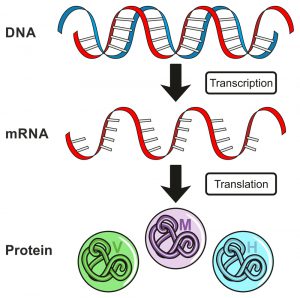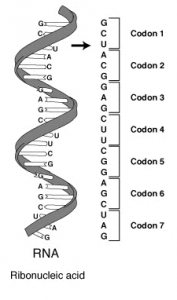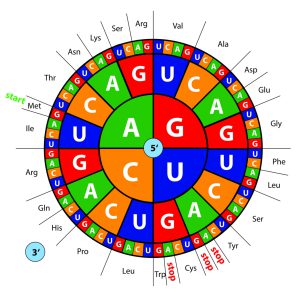
Sometimes I just can’t help myself. I know it’s clickbait but I click on the link anyway.
A few days ago, as a result of momentary weakness, I found myself reading an article from the ScoopWhoop website, “16 Things Most of Us Think Are the Same but Actually Aren’t.”
OK. OK. Now that you saw the title you want to click on the link, too.
To save you from wasting five minutes of your life, here is the ScoopWhoop list:
- Weather and Climate
- Turtle and Tortoise
- Jam and Jelly
- Eraser and Rubber
- Great Britain and the UK
- Pill and Tablet
- Shrimp and Prawn
- Butter and Margarine
- Orange and Tangerine
- Biscuits and Cookies
- Cupcakes and Muffins
- Mushrooms and Toadstools
- Tofu and Paneer
- Rabbits and Hares
- Alligators and Crocodiles
- Rats and Mice
And there you have it. Not a very impressive list, really.
If I were putting together a biochemist’s version of this list, I would start with synonymous mutations. Even though many life scientists think they are the same, studies indicate that they “actually aren’t.”
If you have no idea what I am talking about or what this insight has to do with the creation/evolution debate, let me explain by starting with some background information, beginning with the central dogma of molecular biology and the genetic code.
Central Dogma of Molecular Biology
According to this tenet of molecular biology, the information stored in DNA is functionally expressed through the activities of proteins. When it is time for the cell’s machinery to produce a particular protein, it copies the appropriate information from the DNA molecule through a process called transcription and produces a molecule called messenger RNA(mRNA). Once assembled, mRNA migrates to the ribosome, where it directs the synthesis of proteins through a process known as translation.

Figure 1: The central dogma of molecular biology. Image credit: Shutterstock
The Genetic Code
At first glance, there appears to be a mismatch between the stored information in DNA and the information expressed in proteins. A one-to-one relationship cannot exist between the four different nucleotides that make up DNA and the twenty different amino acids used to assemble proteins. The cell handles this mismatch by using a code comprised of groupings of three nucleotides, called codons, to specify the twenty different amino acids.

Figure 2: Codons. Image credit: Wikipedia
The cell uses a set of rules to relate these nucleotide triplet sequences to the twenty amino acids that comprise proteins. Molecular biologists refer to this set of rules as the genetic code. The nucleotide triplets represent the fundamental units of the genetic code. The code uses each combination of nucleotide triplets to signify an amino acid. This code is essentially universal among all living organisms.
Sixty-four codons make up the genetic code. Because the code only needs to encode twenty amino acids, some of the codons are redundant. That is, different codons code for the same amino acid. In fact, up to six different codons specify some amino acids. Others are specified by only one codon.1

Figure 3: The genetic code. Image credit: Shutterstock
A little more background information about mutations will help fill out the picture.
Mutations
A mutation refers to any change that takes place in the DNA nucleotide sequence. DNA can experience several different types of mutations. Substitution mutations are one common type. When a substitution mutation occurs, one (or more) of the nucleotides in the DNA strand is replaced by another nucleotide. For example, an A may be replaced by a G, or a C may be replaced by a T. This substitution changes the codon. Interestingly, the genetic code is structured in such a way that when substitution mutations take place, the resulting codon often specifies the same amino acid (due to redundancy) or an amino acid that has similar chemical and physical properties to the amino acid originally encoded.
Synonymous and Nonsynonymous Mutations
When substitution mutations generate a new codon that specifies the same amino acid as initially encoded, it’s referred to as a synonymous mutation. However, when a substitution produces a codon that specifies a different amino acid, it’s called a nonsynonymous mutation.
Nonsynonymous mutations can be deleterious if they affect a critical amino acid or if they significantly alter the chemical and physical profile along the protein chain. If the substituted amino acid possesses dramatically different physicochemical properties from the native amino acid, it may cause the protein to fold improperly. Improper folding impacts the protein’s structure, yielding a biomolecule with reduced or even lost function.
On the other hand, biochemists have long thought that synonymous mutations have no effect on protein structure and function because these types of mutations don’t change the amino acid sequences of proteins. Even though biochemists think that synonymous mutations are silent—having no functional consequences—evolutionary biologists find ways to use them, including using patterns of synonymous mutations to establish evolutionary relationships.
Patterns of Synonymous Mutations and the Case for Biological Evolution
Evolutionary biologists consider shared genetic features found in organisms that naturally group together as compelling evidence for common descent. One feature of particular interest is the identical (or nearly identical) DNA sequence patterns found in genomes. According to this line of reasoning, the shared patterns arose as a result of a series of substitution mutations that occurred in the common ancestor’s genome. Presumably, as the varying evolutionary lineages diverged from the nexus point, they carried with them the altered sequences created by the primordial mutations.
Synonymous mutations play a significant role in this particular argument for common descent. Because synonymous mutations don’t alter the amino acid sequence of proteins, their effects are considered to be inconsequential. So, when the same (or nearly the same) patterns of synonymous mutations are observed in genomes of organisms that cluster together into the same group, most life scientists interpret them as compelling evidence of the organisms’ common evolutionary history.
It is conceivable that nonsynonymous mutations, which alter the protein amino acid sequences, may impart some type of benefit and, therefore, shared patterns of nonsynonymous changes could be understood as evidence for shared design. (See the last section of this article.) But this is not the case when it comes to synonymous mutations, which raises the question: Why would a Creator intentionally introduce new codons that code for the same amino acid into genes when these changes have no functional utility?
Apart from invoking a Creator, the shared patterns of synonymous mutations make perfect sense if genomes have been shaped by evolutionary processes and an evolutionary history. However, this argument for biological evolution (shared ancestry) and challenge to a creation model interpretation (shared design) hinges on the underlying assumption that synonymous mutations have no functional consequence.
But what if this assumption no longer holds?
Synonymous Mutations Are Not Interchangeable
Biochemists used to think that synonymous mutations had no impact whatsoever on protein structure and, hence, function, but this view is changing thanks to studies such as the one carried out by researchers at University of Colorado, Boulder.2
These researchers discovered synonymous mutations that increase the translational efficiency of a gene (found in the genome of Salmonella enterica). This gene codes for an enzyme that plays a role in the biosynthetic pathway for the amino acid arginine. (This enzyme also plays a role in the biosynthesis of proline.) They believe that these mutations alter the three-dimensional structure of the DNA sequence near the beginning of the coding portion of the gene. They also think that the synonymous mutations improve the stability of the messenger RNA molecule. Both effects would lead to greater translational efficiency at the ribosome.
As radical (and unexpected) as this finding may seem to be, it follows on the heels of other recent discoveries that also recognize the functional importance of synonymous mutations.3Generally speaking, biochemists have discovered that synonymous mutations function to influence not only the rate and efficiency of translation (as the scientists from the University of Colorado, Bolder learned) and the folding of the proteins after they are produced at the ribosome.
Even though synonymous mutations leave the amino acid sequence of the protein unchanged, they can exert influence by altering the:
- regulatory regions of the gene that influence the transcription rate
- secondary and tertiary structure of messenger RNA that influences the rate of translation
- stability of messenger RNA that influences the amount of protein produced
- translation rate that influences the folding of the protein as it exits the ribosome
Biochemists are just beginning to come to terms with the significance of these discoveries, but it is already clear that synonymous mutations have biomedical consequences.4 They also impact models for molecular evolution. But for now, I want to focus on the impact these discoveries has on the creation/evolution debate.
Patterns of Synonymous Mutations and the Case for Creation
As noted, many people consider the most compelling evidence for common descent to be the shared genetic features displayed by organisms that naturally cluster together. But if life is the product of a Creator’s handiwork, the shared genetic features could be understood as shared designs deployed by a Creator. In fact, a historical precedent exists for the common design interpretation. Prior to Darwin, biologists viewed shared biological features as manifestations of archetypical designs that existed in the Creator’s mind.
But the common design interpretation requires that the shared features be functional. (Or, that they arise independently in a nonrandom manner.) For those who view life from the framework of the evolutionary paradigm, the shared patterns of synonymous mutations invalidate the common design explanation—because these mutations are considered to be functionally insignificant.
But in the face of mounting evidence for the functional importance of synonymous mutations, this objection to common design has begun to erode. Though many life scientists are quick to dismiss the common design interpretation of biology, advances in molecular biology continue to strengthen this explanation and, with it, the case for a Creator.
Resources
- Who Was Adam? A Creation Model Approach to the Origin of Humanity, 2nd exp ed., by Fazale Rana with Hugh Ross (book)
- The Cell’s Design: How Chemistry Reveals the Creator’s Artistry by Fazale Rana (book)
- “Biochemical Synonyms Optimized, Part 1” by Fazale Rana (article)
- “Biochemical Synonyms Optimized, Part 2” by Fazale Rana (article)
- “Nonrandom Mutations Scramble the Case for Common Descent” by Fazale Rana (article)
- “Alu Sequences in Primate Genomes: Evidence for Common Descent or Common Design?” by Fazale Rana (article)
- “Archetype or Ancestor? Sir Richard Owen and the Case for Design” by Fazale Rana (article)
Endnotes
- As I discuss in The Cell’s Design, the rules of the genetic code and the nature of the redundancy appear to be designed to minimize errors in translating information from DNA into proteins that would occur due to substitution mutations. This optimization stands as evidence for the work of an intelligent Agent.
- JohnCarlo Kristofich et al., “Synonymous Mutations Make Dramatic Contributions to Fitness When Growth Is Limited by Weak-Link Enzyme,” PLoS Genetics 14, no. 8 (August 27, 2018): e1007615, doi:10.1371/journal.pgen.1007615.
- Here are a few representative studies that ascribe functional significance to synonymous mutations: Anton A. Komar, Thierry Lesnik, and Claude Reiss, “Synonymous Codon Substitutions Affect Ribosome Traffic and Protein Folding during in vitro Translation,” FEBS Letters 462, no. 3 (November 30, 1999): 387–91, doi:10.1016/S0014-5793(99)01566-5; Chung-Jung Tsai et al., “Synonymous Mutations and Ribosome Stalling Can Lead to Altered Folding Pathways and Distinct Minima,” Journal of Molecular Biology 383, no. 2 (November 7, 2008): 281–91, doi:10.1016/j.jmb.2008.08.012; Florian Buhr et al., “Synonymous Codons Direct Cotranslational Folding toward Different Protein Conformations,” Molecular Cell Biology 61, no. 3 (February 4, 2016): 341–51, doi:10.1016/j.molcel.2016.01.008; Chien-Hung Yu et al., “Codon Usage Influences the Local Rate of Translation Elongation to Regulate Co-translational Protein Folding,” Molecular Cell Biology 59, no. 5 (September 3, 2015): 744–55, doi:10.1016/j.molcel.2015.07.018.
- Zubin E. Sauna and Chava Kimchi-Sarfaty,” Understanding the Contribution of Synonymous Mutations to Human Disease,” Nature Reviews Genetics 12 (August 31, 2011): 683–91, doi:10.1038/nrg3051.
Reprinted with permission by the author
Original article at:
https://www.reasons.org/explore/blogs/the-cells-design/read/the-cells-design/2019/03/13/biochemical-synonyms-restate-the-case-for-a-creator